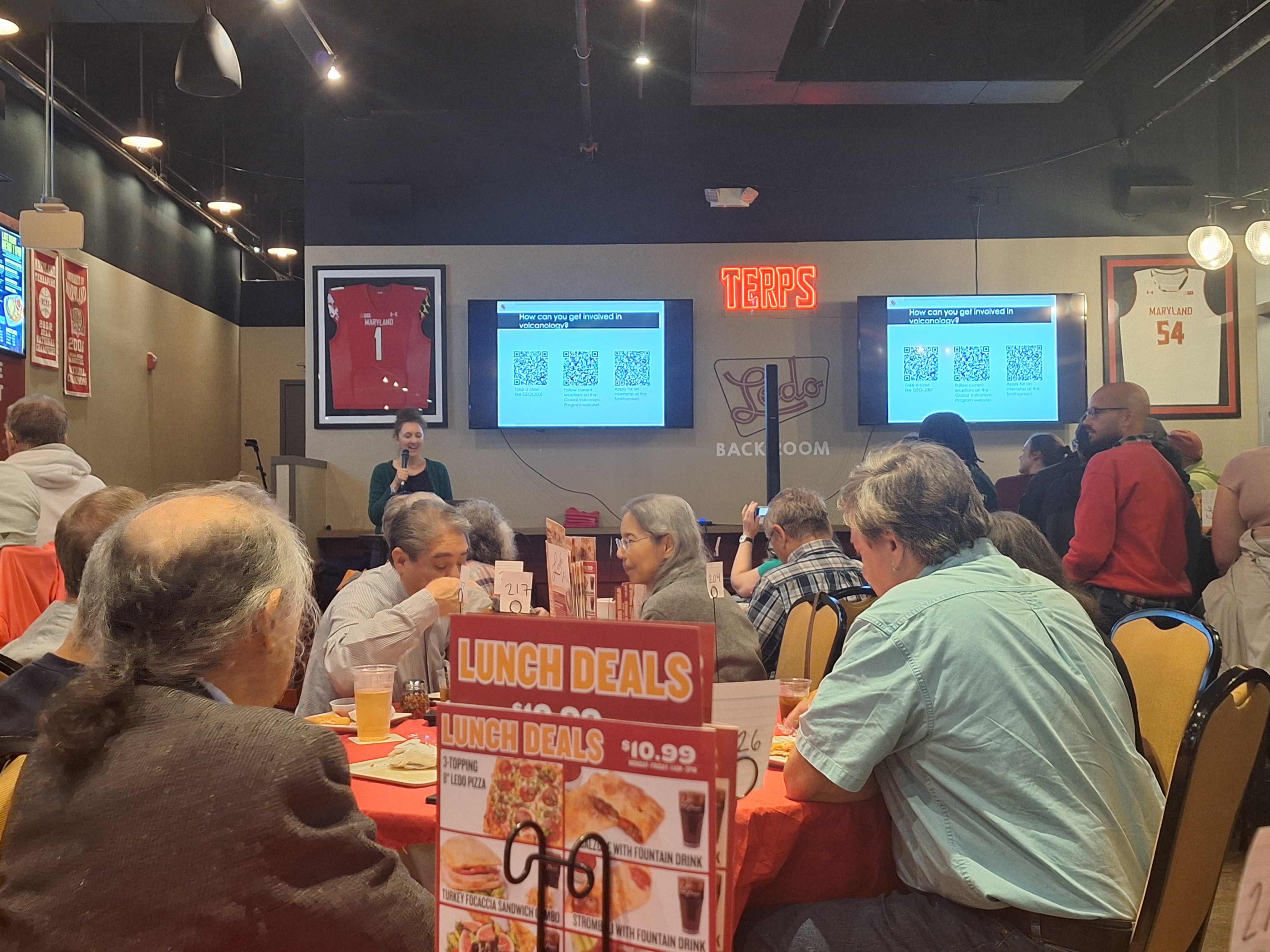Event name: Science on Tap Lecture Series
Presentation title: "Belly of the Beast: What Happens Beneath Volcanoes to Make Them Erupt?"
Event time and place: Monday, September 30, 2024 at 6:30 p.m., Ledo Pizza, Knox Rd., College Park, MD
Summary
Dr. Newcombe began her talk by describing the processes within the Earth's mantle that lead to volcanic eruptions. She described the two general types of volcanic eruptions (effusive and diffusive), comparing them to bottles of Coca-Cola. In both cases, dissolved gas (CO2 in Coke vs. H2O and other chemicals in magma) form bubbles in low pressure, which start to rise and increase in size, dragging the magma with them and building up the pressure until the cap pops off.

Dr. Newcombe speaking in the tap room of Ledo Pizza.
Dr. Newcombe discussed the magma's 3-phase property, consisting of a viscous silicate glass-like liquid, silicate crystals, and vapor bubbles. As magma rises to the surface, the silicate liquid dries out and forms the crystals. Sometimes, small parcels of magma can be trapped during this process, providing the opportunity to study what goes on deep within the volcano.
Scientists use several methods to forecast eruptions, such as measuring gas composition and remote sensing. However, Dr. Newcombe explained that there is no one perfect forecast. Volcanic eruptions can be sensed weeks to even decades in advance, and it's difficult to know when an eruption will end. The eruption of Mount Pinatubo in the Philippines (2nd largest ever) was forecasted two months prior to eruption, but they got lucky. Dr. Newcombe noted that false warnings cost money and erode public confidence.
The final section focused on the field research of a former student, Silvia, who studied the past eruptions of Cerro Machin in Colombia. Silvia found similarities in the volcanic ash deposits in the side of the mountain to Mount Pinatubo. Cerro Machin has erupted at least six times, with the last eruption around 900 years ago. This pattern and recent seismic activity has raised concerns of an imminent eruption. While testing the underground magma for water content would be the best method to determine eruption forecasting, this is obviously not practical. Dr. Newcombe described how electron spectroscopy can be used to examine the "zoning" of old magma crystals to give information about the growth history of the crystal and thereby the happenings within the volcano.
Dr. Newcombe ended her talk by explaining the various future goals for the field of volcanology, including educating local communities about how to keep safe from eruptions and what realistic forecasting looks like, as well as lobbying for increased funding for monitoring and scientific research.
Analysis
Dr. Newcombe's presentation on volcanic eruptions was fascinating and certainly effective. She conveyed the complexity of volcanic systems through the use of metaphors, detailed explanations, and interesting current research. On the other hand, her talk left some questions underexplored, particularly regarding the limits of forecasting.
One of the most engaging parts of Dr. Newcombe's talk was her use of the Coca-Cola analogy to explain eruptions. Comparing the release of dissolved gas in magma to the CO2 bubbles in soda was a great way to capture the listener's attention and explain a difficult concept in a simple way. This, along with her explanation of magma's three-phase composition, provided a clear understanding of the physical and chemical factors at play.
The discussion of forecasting methods was also very interesting, detailing the high quality yet limited tools of volcanology. Things like gas composition analysis, remote sensing, and seismic measurements offer valuable insights into volcanic activity. The Mount Pinatubo case study illustrated how these tools can save lives. Dr. Newcombe also acknowledged the challenges of prediction, and this perspective depicts the high stakes, in terms of human safety and scientific credibility.
Despite these strengths, the presentation could have more detail on the uncertainties of volcanic forecasting. Dr. Newcombe emphasized the unpredictability of eruptions and the need for better understanding of volcanic behavior, but she didn't fully explain why existing methods fall short. For example, what specific gaps in our knowledge prevent accurate long-term forecasts? The talk could have provided a more comprehensive picture of the field by raising these questions.
Additionally, the conclusion of the talk, on further education and the need for funding, felt rushed. Dr. Newcombe's call to action could have been more impactful if she had included concrete examples of successful policy advocacy or research. For example, how have other regions effectively combined scientific forecasting with local disaster preparedness and recovery initiatives? What can be done by researchers and governments to address the difference between the number of active volcanoes and monitoring stations? If Dr. Newcombe had expanded on these points, it could have provided a stronger foundation for her argument.
All in all, Dr. Newcombe's presentation was successful in detailing the intricate processes of volcanic activity and the practical challenges of prediction. However, a more lengthy discussion of the uncertainties in forecasting could have elevated the discussion. In the end, her talk was effective at educating as well as provoking discussion, as seen in the multitude of questions that were sparked after her presentation.


